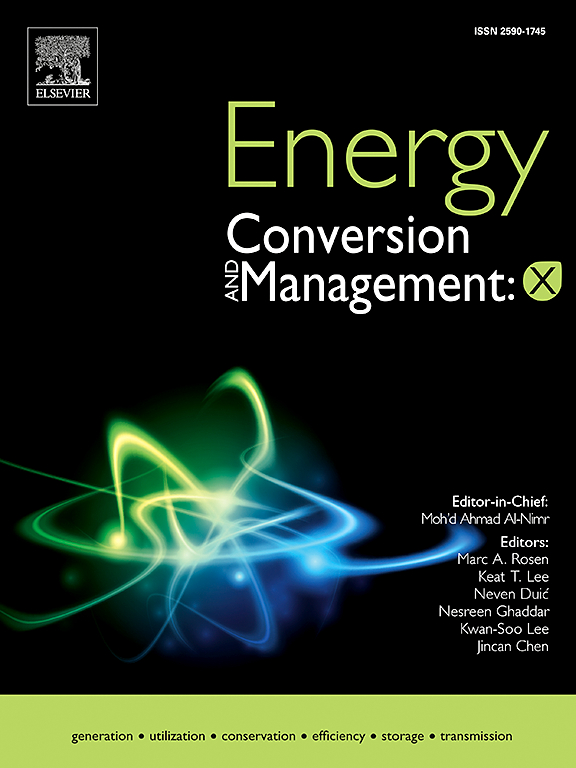Analysis of single-cell shading impact on polycrystalline PERC module under hot-dry conditions
IF 7.6
Q1 ENERGY & FUELS
引用次数: 0
Abstract
PV technologies may often perform differently under outdoor operating conditions compared with Standard Test Conditions, which are performed under a controlled setup inside a laboratory. Outdoor-installed PV modules are exposed to continuously varying factors, like solar radiation and temperature, which significantly impact their electrical and thermal behavior. Moreover, due to prolonged exposure to these dynamic conditions, outdoor-installed PV modules are subject to gradual degradation over time. One frequently occurring degradation is partial shading, which can lead to hotspot formation in shaded modules. To predict the formation of the hotspot, it is essential to understand the impact of partial shading in a PV module. In this investigation, indoor and outdoor partial shading stress experiments are conducted on a single cell in a PV module. This methodology accelerates the degradation, and the impact of single-cell shading on the performance of a PV module is analysed. The results are extracted using obtaining I-V and P-V curves for different shading conditions, and various performance parameters like output power and efficiency are recorded to analyse the electrical and thermal response of a shaded module. The experiments performed in outdoor conditions recorded power loss as high as 49 %, and efficiency dropped to 8.11 % from its initial unshaded conditions. Additionally, the results confirm the occurrence of hotspot due to shading. Though indoor experiments did not exhibit any visible temperature rise in the shaded cell, outdoor experiments showed a significant thermal response. The highest temperature of 92.3°C was recorded in the shaded cell under a 40 % single-cell shading condition, highlighting the pronounced impact of real shading and environmental conditions on thermal behavior of a PV module.
热干条件下单细胞遮阳对多晶PERC组件的影响分析
与标准测试条件相比,光伏技术在室外操作条件下的表现往往不同,标准测试条件是在实验室内的受控设置下进行的。户外安装的光伏组件暴露在不断变化的因素中,如太阳辐射和温度,这些因素会显著影响其电气和热性能。此外,由于长时间暴露在这些动态条件下,户外安装的光伏组件会随着时间的推移而逐渐退化。一个经常发生的退化是部分遮光,这可能导致在遮光模块中形成热点。为了预测热点的形成,有必要了解光伏组件中部分遮阳的影响。在本研究中,对光伏组件中的单个电池进行了室内和室外部分遮阳应力实验。这种方法加速了退化,并分析了单细胞遮阳对光伏组件性能的影响。通过获取不同遮光条件下的I-V和P-V曲线提取结果,并记录输出功率和效率等各种性能参数,分析遮光模块的电响应和热响应。在室外条件下进行的实验记录了高达49%的功率损耗,效率从最初的无遮蔽条件下降到8.11%。此外,结果还证实了由于遮阳而出现的热点。虽然室内实验没有显示出任何明显的温度上升,但室外实验显示出明显的热响应。在单电池遮阳40%的条件下,遮阳电池的最高温度为92.3°C,突出了真实遮阳和环境条件对光伏组件热行为的显著影响。
本文章由计算机程序翻译,如有差异,请以英文原文为准。
求助全文
约1分钟内获得全文
求助全文
来源期刊

Energy Conversion and Management-X
Multiple-
CiteScore
8.80
自引率
3.20%
发文量
180
审稿时长
58 days
期刊介绍:
Energy Conversion and Management: X is the open access extension of the reputable journal Energy Conversion and Management, serving as a platform for interdisciplinary research on a wide array of critical energy subjects. The journal is dedicated to publishing original contributions and in-depth technical review articles that present groundbreaking research on topics spanning energy generation, utilization, conversion, storage, transmission, conservation, management, and sustainability.
The scope of Energy Conversion and Management: X encompasses various forms of energy, including mechanical, thermal, nuclear, chemical, electromagnetic, magnetic, and electric energy. It addresses all known energy resources, highlighting both conventional sources like fossil fuels and nuclear power, as well as renewable resources such as solar, biomass, hydro, wind, geothermal, and ocean energy.
 求助内容:
求助内容: 应助结果提醒方式:
应助结果提醒方式:


